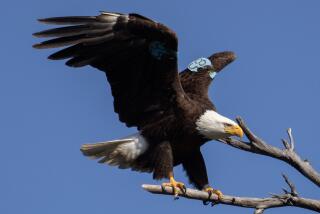How the cuckoo tricks a bird of a different feather
Maybe these finches aren’t so cuckoo after all.
The African cuckoo finch is a notorious trickster, short-cutting the chores of parenthood by hiding its eggs in the nest of the African tawny-flanked prinia, which wind up hatching and raising them.
Such parasitic nesting relationships are relatively common among birds, and tend to set off a co-evolutionary arms race – host species improve their ability to reject eggs, and interlopers’ eggs become better mimics.
The African cuckoo finch, however, appears to have the upper wing. It lays multiple eggs in the same nest, making it harder for the host to differentiate among her own eggs and those of the interloper, according to a study published online Tuesday in the journal Nature Communications.
Researchers from the universities of Cambridge and Cape Town wanted to know how the prinias figured out if eggs were foreign, and how the cuckoos get around that skill. Were the prinia just pecking the odd-egg-out (a purely sensory decision), or did they use a mental “template” of what their own eggs should look like, and make cognitive choices?
Each tactic carries some uncertainty. If the prinias simply reject the visually “discordant” eggs, then they could reject all of their own when they were outnumbered by interloper eggs. If their decisions were driven only by a template, then they should reject all foreign eggs regardless of their proportion to native eggs.
Neither turns out to be entirely true. The prinias were pretty good at rejecting foreign eggs – in 31 of 48 trials, they rejected at least one embryonic interloper. But they still accepted all eggs in 17 trials, and that’s enough for the cuckoo strategy to be not so cuckoo after all.
Researchers said the prinias appeared to use a dual strategy to sort out the eggs. But as the proportion of foreign eggs increased, visual differences between foreign and native eggs, such as color, had to be much stronger to trigger a rejection, the Cambridge researchers found. It was as if the host bird were erring on the side of caution, since its own eggs tend to vary slightly.
So, if the cuckoo’s eggs are reasonably close to the variations of the prinia eggs, the cuckoo should benefit from laying more than one egg in the same host’s nest, researchers suggested. It has evolved a strategy to take advantage of a cognitive weakness in its host.
That might raise the question of which bird is more cuckoo.







